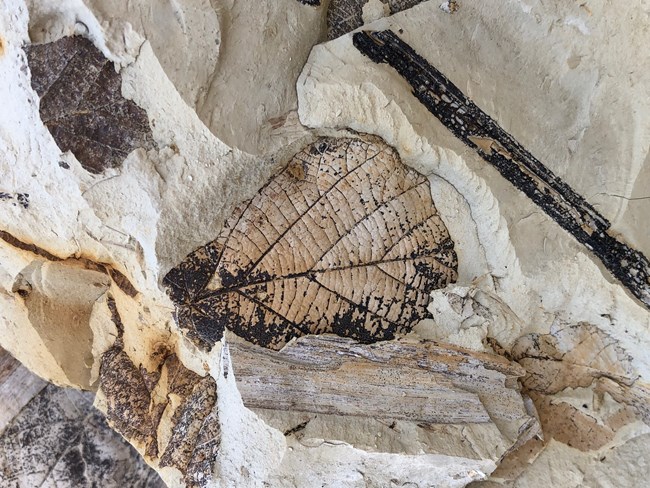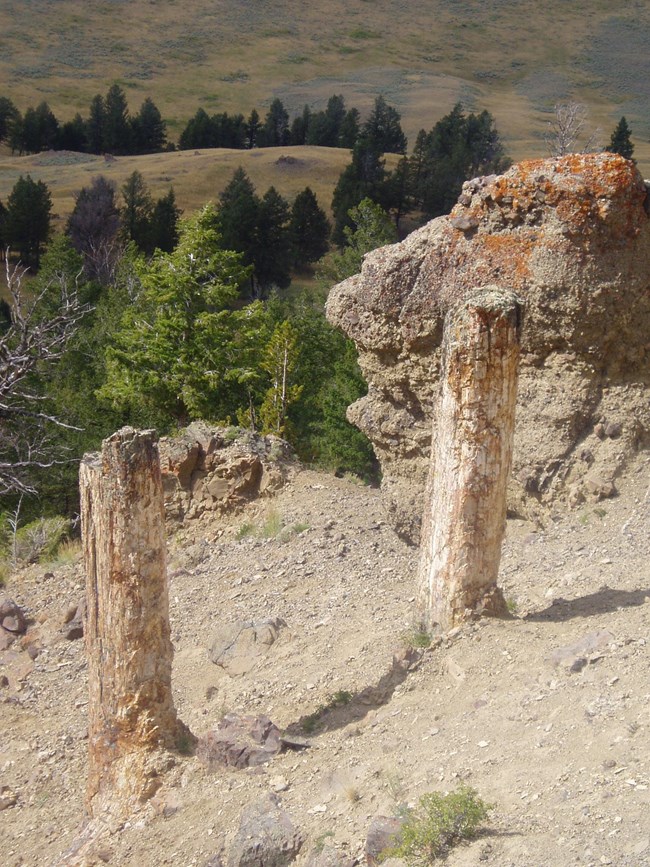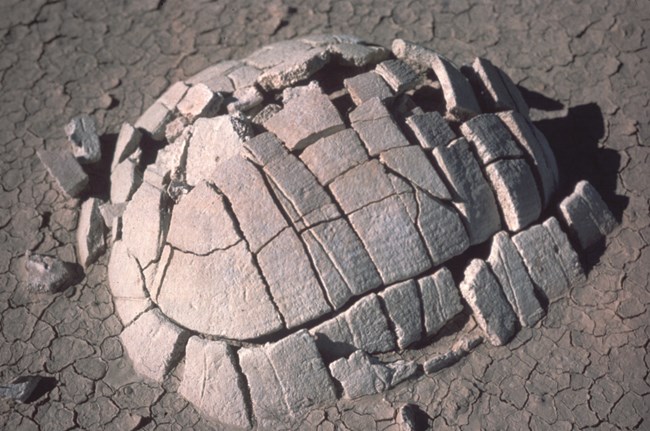Part of a series of articles titled Geologic Time Periods in the Cenozoic Era.
Previous: Neogene Period—23.0 to 2.58 MYA
Article

NPS image
Geologists have traditionally divided the Cenozoic Era into two periods: Tertiary and Quaternary, with each period further divided into epochs. Although “Tertiary” and “Quaternary” are still widely used, a different scheme for designating Cenozoic time is becoming increasingly popular. This scheme is reflected in the International Commission on Stratigraphy’s stratigraphic chart this page follows.
The Paleogene Period is the first of three periods in the Cenozoic Era. The Paleogene represents less than 1% of geologic time; however, the rocks of this period were deposited quite recently and are, therefore, at or near Earth’s surface. Additionally, these rocks have been little altered (many Paleogene formations are not even truly lithified and are more accurately described as “deposits”, rather than rocks), thereby making access and interpretation easier than for rocks of previous eras. Hence, though they represent a small fraction of geologic time, scientists have been able to learn much about them. The Paleogene Period is divided into three epochs: Paleocene, Eocene, and Oligocene.

NPS image
The initial epoch of the Paleogene Period and the Cenozoic Era is the Paleocene Epoch, which marks the first subdivision of geologic time after the extinction of the dinosaurs and the end of the Cretaceous Period. In western North America, the uplift of the Rocky Mountains, which started in the Cretaceous, continued throughout the Paleocene. This mountain-building event marked a decline of an inland seaway, the Cretaceous Interior Seaway, that had extended from the Arctic Ocean to the Gulf of Mexico.
The Fort Union Group, composed of rocks laid down during this epoch, is noteworthy because it overlies undeformed upper Cretaceous sediments, thus recording the demise of the dinosaurs and the rise of mammals in many areas. The formations that comprise this group at Theodore Roosevelt National Park in North Dakota are the Sentinel Butte and Bullion Creek. These formations contain fossil tree stumps in growth position, freshwater mollusks, turtles, and champsosaur (crocodile-like aquatic reptiles) remains. In Big Bend National Park in Texas the Black Peaks Formation also preserves fossil trees and vertebrates from the Paleocene.
Though recent research indicates that the diversity of Mesozoic mammals was greater than once thought, most mammal fossils from the beginning of the Cenozoic (Paleogene Period) were small herbivores. By mid-Paleocene, the ungulates—hoofed mammals of initially five-toed forms—became abundant. Prosimian primates (tree shrews and tarsiers) also increased in number. Some of the fossil evidence from Paleocene sediments is difficult to explain. Alaska, for example, clearly had broad-leafed, evergreen floras that typically grow in tropical forests. As the land has not changed significantly in latitude since the Paleocene, the evidence of these floras is a puzzle. A possible hypothesis is that terranes transported these “tropical” rocks to Alaska.

NPS image
The Eocene in North America was marked by the submergence of the Great Valley of California and a portion of the Atlantic and Gulf coastal plain, which extended from New Jersey to Texas and into the present Mississippi River valley as far north as southern Illinois. Additionally, sediment deposition was extensive in the Rocky Mountains. Eocene sedimentary formations along the Atlantic-Gulf coast are chiefly sand, clay, and marl, with some limestone and lignite; in California, Oregon, and Washington they consist of shale and sandstone, with oil and coal. The Badlands of the West are partly cut into Eocene rock formations, for example, the Wasatch, Green River, Bridger, and Uinta formations, which contain great quantities of volcanic ash and in some districts oil-producing shale. The Green River Formation of southwestern Wyoming is noteworthy for its freshwater fossil fish found at Fossil Butte National Monument. Other lake deposits found at Florissant Fossil Beds National Monument in Colorado preserve a wide variety of plants and insects. The brightly colored Wasatch Formation makes up the spectacular pillars of Bryce Canyon National Park in Utah.
During the Eocene, the ancestors of present-day mammals of Europe and North America made their appearance, possibly as immigrants from other regions. Eocene mammals included ancestral rhinoceroses, tapirs, camels, pigs, rodents, monkeys, whales, and the ancestral horse, as well as animals such as the brontotheres, which have since become extinct. The brontotheres—mammals remotely related to the horse and the rhinoceros—evolved to types of great size, then died out. The vegetation of the Eocene was fairly modern. Badlands National Park is a world-renowned location for late Eocene faunas.

NPS image
More of North America was dry land during the Oligocene than in the preceding Eocene Epoch. The Gulf Coast was flooded, but the Atlantic Coast north of South Carolina became emergent. The principal formation of the Gulf Coast region is the Vicksburg Limestone which can be seen at Vicksburg National Military Park. The Pacific Coast, like the more northern Atlantic Coast, was largely elevated and its erosion led to the deposition of sediments. The great erosion of the Rocky Mountains was responsible for the deposition of the fossil-rich White River Group clay and sand over large areas of western Nebraska and northeastern Colorado and parts of Wyoming and the Dakotas, including Badlands National Park in South Dakota. Late in the Oligocene, the John Day deposits, notable for their fossils, formed in Oregon. During the Oligocene, volcanoes erupted in the San Juan Mountains of Colorado and the Absaroka Mountains of Wyoming where unrelated volcanism still persists in Yellowstone National Park.
The climate of the Oligocene was mild and temperate in North America. The virtual disappearance of the archaic mammals of the Paleocene marks Oligocene evolution in Europe and North America. Carnivorous mammals—ancestral dogs and cats—made their appearance, along with beavers, mice, rabbits, and squirrels. Camels, entelodonts (extinct ancestors of modern pigs and other hoofed animals), and a more highly developed type of horse appeared. Both terrestrial and aquatic rhinoceroses evolved, particularly notable in the National Park System are the fossil remains of the rhinoceros (Subhyrocodon occidentalis) from Badlands National Park in South Dakota.
The extinction event at the end of the Cretaceous Period opened numerous ecological niches. These were filled mostly by mammals, which underwent a dramatic evolutionary radiation. By the end of the Cenozoic Era, North America was home to mastodons, ground sloths, armadillos, camels, horses, saber-toothed cats, giant wolves, giant beavers, and giant bears. Birds also began to diversify and occupy new niches during this time. In addition, many familiar plants such as pines, cacti, and palms appeared. Also, grasses developed into expansive grasslands, which spread across the continent.
Every park contains some slice of geologic time. Here we highlight a few parks associated with the Paleogene Period. This is not to say that a particular park has only rocks from the specified period. Rather, rocks in selected parks exemplify a certain event or preserve fossils or rocks from a certain geologic age.
Agate Fossil Beds National Monument (AGFO), Nebraska—[AGFO Geodiversity Atlas] [AGFO Park Home] [AGFO npshistory.com]
Badlands National Park (BADL), South Dakota—[BADL Geodiversity Atlas] [BADL Park Home] [BADL npshistory.com]
Big Bend National Park (BIBE), Texas—[BIBE Geodiversity Atlas] [BIBE Park Home] [BIBE npshistory.com]
Bryce Canyon National Park (BRCA), Utah—[BRCA Geodiversity Atlas] [BRCA Park Home] [BRCA npshistory.com]
Cedar Breaks National Monument (CEBR), Utah—[GCEBR Geodiversity Atlas] [CEBR Park Home] [CEBR npshistory.com]
Chiricahua National Monument (CHIR), Arizona—[CHIR Geodiversity Atlas] [CHIR Park Home] [CHIR npshistory.com]
City of Rocks National Reserve (CIRO), Idaho—[CIRO Geodiversity Atlas] [CIRO Park Home] [CIRO npshistory.com]
Devils Tower National Monument (DETO), Wyoming—[DETO Geodiversity Atlas] [DETO Park Home] [DETO npshistory.com]
Florissant Fossil Beds National Monument (FLFO), Colorado—[FLFO Geodiversity Atlas] [FLFO Park Home] [FLFO npshistory.com]
John Day Fossil Beds National Monument (JODA), Oregon—[JODA Geodiversity Atlas] [JODA Park Home] [JODA npshistory.com]
Lake Clark National Park (LACL), Alaska—[LACL Geodiversity Atlas] [LACL Park Home] [LACL npshistory.com]
Santa Monica Mountains National Recreation Area (SAMO), California—[SAMO Geodiversity Atlas] [SAMO Park Home] [SAMO npshistory.com]
Scotts Bluff National Monument (SCBL), Nebraska—[SCBL Geodiversity Atlas] [SCBL Park Home] [SCBL npshistory.com]
Theodore Roosevelt National Park (THRO), North Dakota—[THRO Geodiversity Atlas] [THRO Park Home] [THRO npshistory.com]
Vicksburg National Military Park (VICK), Mississippi—[VICK Geodiversity Atlas] [VICK Park Home] [VICK npshistory.com]
Yellowstone National Park (YELL), Idaho, Montana, Wyoming—[YELL Geodiversity Atlas] [YELL Park Home] [YELL npshistory.com]
Part of a series of articles titled Geologic Time Periods in the Cenozoic Era.
Previous: Neogene Period—23.0 to 2.58 MYA
Last updated: April 27, 2023